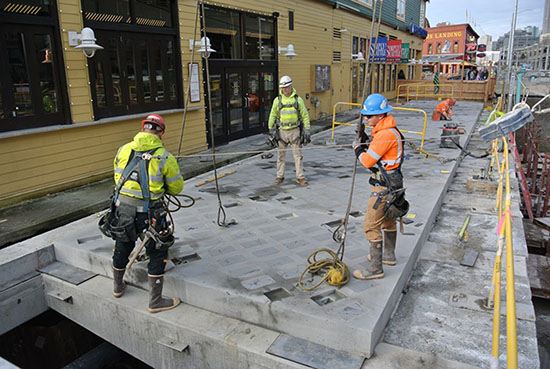|
Subscribe / Renew |
|
|
Contact Us |
|
| ► Subscribe to our Free Weekly Newsletter | |
| home | Welcome, sign in or click here to subscribe. | login |
Construction
| |
 |
May 9, 2017
Public Works: Infrastructure
Sustainable Merit

Elliott Bay Seawall
Location: Seattle
Owner/developer: Seattle Department of Transportation
Team: Mortenson/Manson Joint Venture, general and concrete contractor; Parsons, structural engineer; APS Architectural Precast Structures, McMillen Jacobs Associates and Oldcastle Precast, precast elements; Stoneway Concrete, ready-mix supplier
The Seattle Department of Transportation’s Elliott Bay Seawall project is a $210 million replacement of the southern 3,500 feet of the seawall supporting Alaskan Way along the waterfront in Seattle.
Encompassing about 27,000 cubic yards of Portland cement concrete, this project replaced the old timber-supported wall with a new structure composed of 434 segments consisting of precast concrete face panels supported by a precast concrete cantilever structure (Z panels) anchored in place using large, cast-in-place, mass-pour slabs (CIP panels).
In addition to supporting the new seawall, the Z panels carry light-penetrating sidewalk panels (LPS panels) perched over Elliott Bay, intended allow ambient light to the sea-life habitat bench constructed in front of the new seawall.
After excavation and demolition of the existing wooden structure behind a sheet pile wall, ground improvement was done. This consisted of injecting Portland cement slurry into the existing mud to construct columns of a mud-Portland cement mixture that provided a stable base to rest the new seawall structure.
After improvements to the subsurface utilities were made, the CIP panels were cast in place. These were mass pours of concrete used as a foundation for the Z panels as well as anchors to keep the Z panels from tipping due to the cantilevered sidewalk.
After curing, the area in front of the CIP panels was excavated to make room for the face panels and restored marine habitat. The precast seawall face panels were then placed, followed by large bags of loose rock (marine mattresses) on the seaward side at the foot of the face panels. The marine mattresses provided stability for the toe of the panels, protection from wave action and habitat for the marine creatures of Elliott Bay.
Z panels were then placed on top of the CIP panels to support the landward side of the face panels and provide structure for the overhanging sidewalk. Steel was added and more concrete was poured between the Z panels to anchor the face panels to the structure as well as tie the Z panels together longitudinally.
The Z panels/CIP panels were backfilled and the LPS panels were placed on the cantilevered structure. Lastly, the surface area was restored in anticipation of the waterfront restoration project.
The project was executed with the environment in mind. Work involved disposal of contaminated soils, extensive use of pozzolans in the concrete mixes, restoration of the marine habitat, and installation of the structurally complex, overhanging LPS panels.
Other Stories:
- Grand Award
Public works: Bridges - Special applications: Resiliency
- Community Award
- Concrete paving
- Pervious concrete
- Artistic and decorative concrete
- Residential concrete
- Public works: Renovations
- Cast-in-place structures
- Cast-in-place structures: Parking garage
Special applications: Technical merit (tie) - Tilt-up structures
- Special applications: Technical merit (tie)


